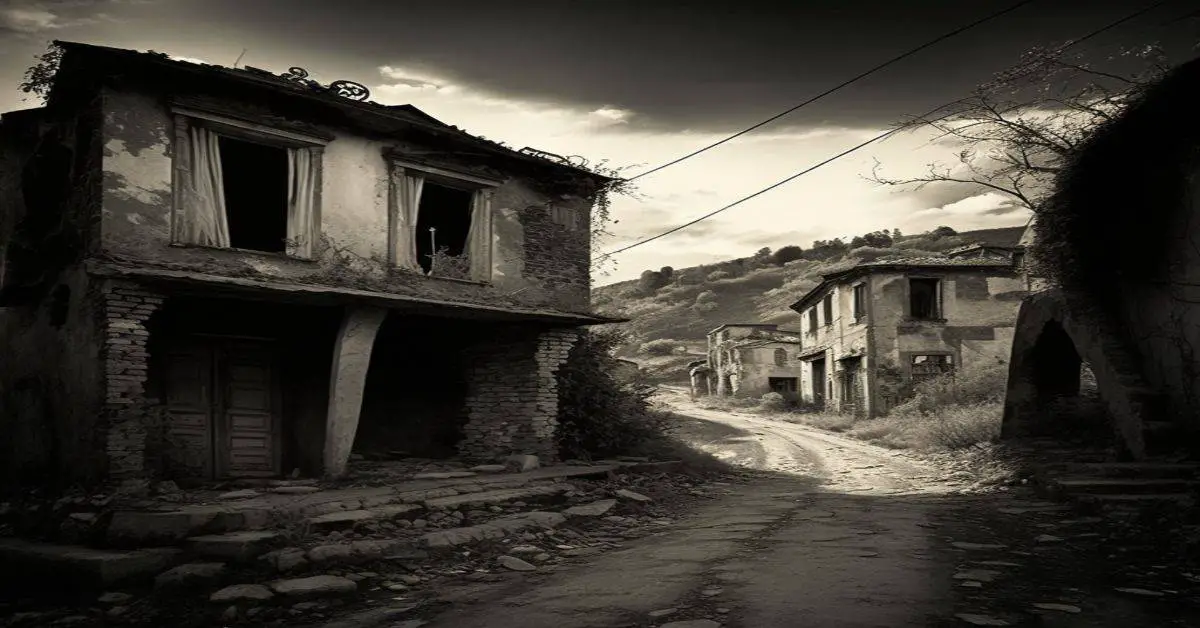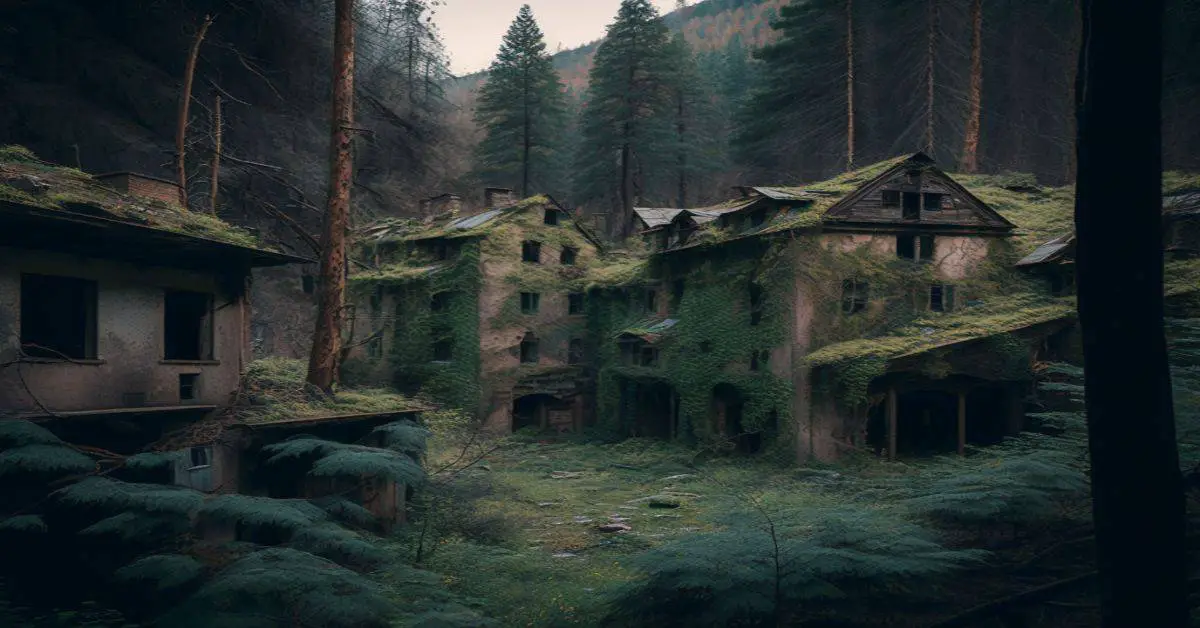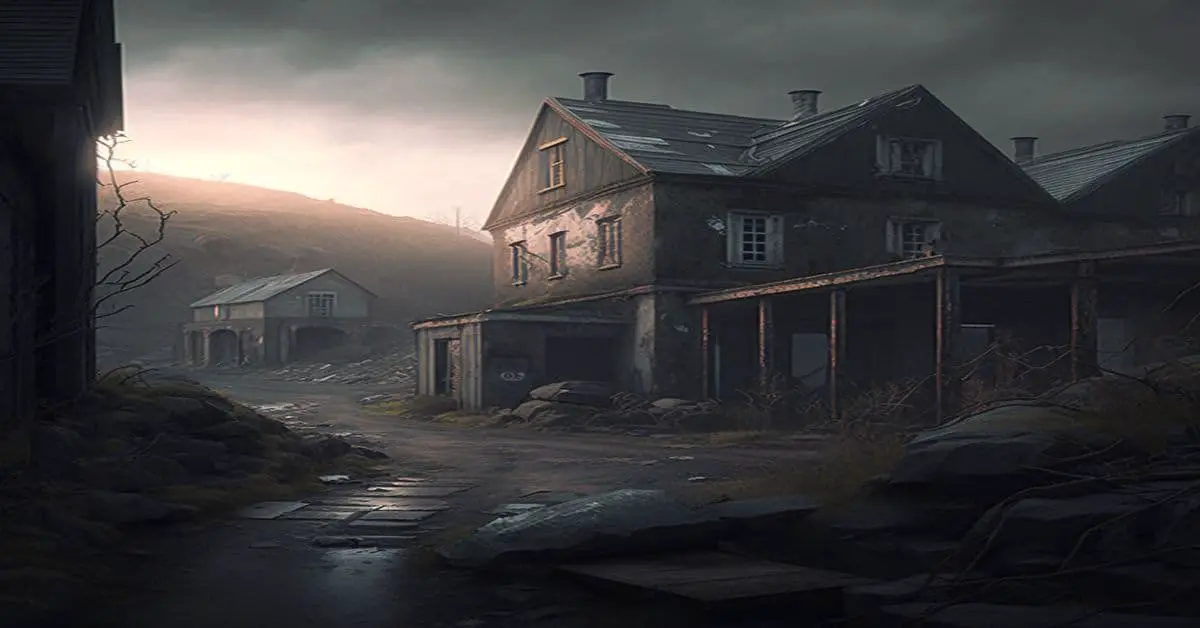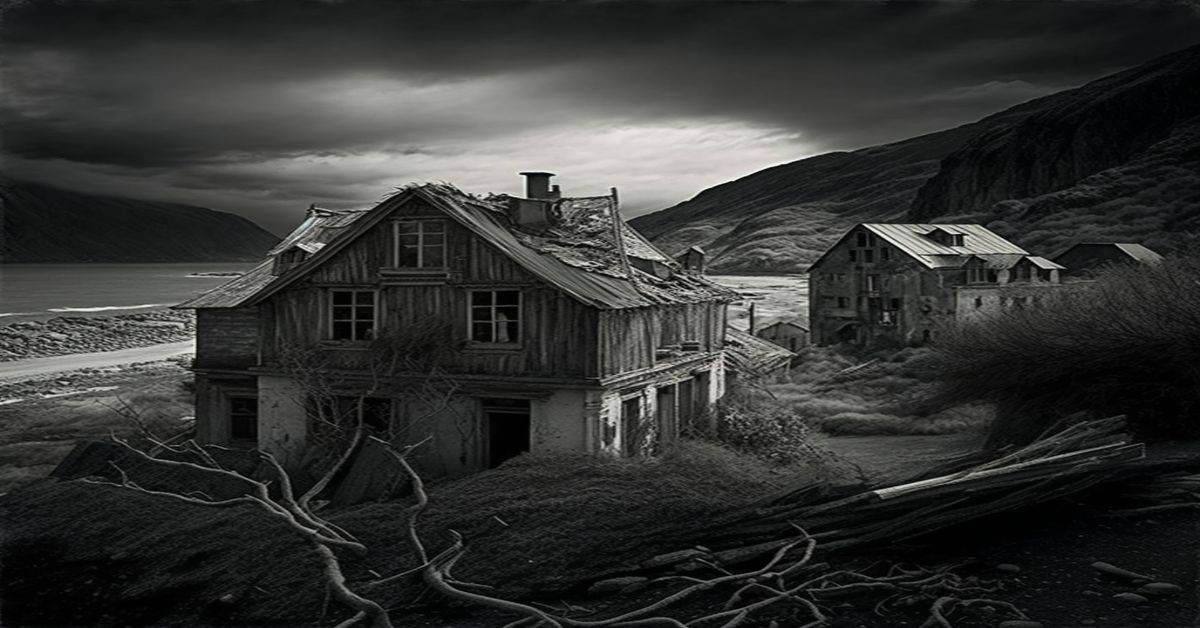The contrast between “what was” and “what could have been” is striking in the case of ghost towns. These once bustling places are now hollowed out, withered versions that carry with them an airy sense as if time has forgotten these faded memories—a haunting sadness prevalent among all things abandoned to nature or circumstance.
Perfect preservation often leaves one feeling like they’re standing right next door to visiting someone’s home before it became dilapidated; every object seems more precious because there won’t ever be another opportunity like this again.
The boomtowns of America’s frontier days are fading away, one by one. In Drummond, Montana, an old gold mining settlement stands frozen in time. In contrast, elsewhere in the Mojave Desert, a former silver city paints picturesque scenes amidst its harsh landscape for visitors to enjoy.
The lure and magic that once was found only here can still be felt at these places, which have witnessed so much change over such long periods – yet they never lose their character or importance because every moment leaves behind something worth preserving.
The 22 best-preserved ghost towns in America are a reminder that not all mining communities were created equal. From the Alaskan coast to North Carolina’s Great Smoky Mountains, there is a richness found in preserving history.
Bodie State Historic Park – Bridgeport, California
The town of Bodie, located in the heart of California’s Gold Country, was once a bustling metropolis during America’s wild west era. This a perfect example to showcase how rugged and daring these individuals who founded this country were centuries ago! Today, however, all that remains are eerily quiet streets lined with ghostly buildings left behind from yesteryear.
By the time Bodie was established as an important mining town, it had grown from a quiet community of 500 people to over 10 thousand inhabitants and 65 saloons. The city’s north end housed many brothels that catered mainly to miners looking for gold or silver and a good time and companionship.
Calico Ghost Town – Yermo, California
Calico in Southern California is a ghost town, but it was once an Old West mining boomtown. Once home to 3,500 residents and an abundance of silver mines that produced over $20 million during its prime time over half a century ago, it is now an empty reminder of the past.
When the price for precious metals steeply declined across America from the 1880s until the 1920s, many towns like Calico fell fast due to economic reasons and changes brought about by improved technology.
Batsto Village – Egg Harbor City, New Jersey
Batsto Village is an 18th-century village that once thrived as a prosperous ironworks but eventually fell into decline and was abandoned.
After years of neglect, it remains today as one nearly perfectly preserved historic landmark with its three valuable resources: water for mills; abundant wood used in the production of charcoal; Bog Iron ore, which can be found mostly near swamps due to acid mine drainage causing dissolution on underlying deposits – giving rise immensely costly environmental problems like pollution if left unchecked.
Eckley Miners’ Village – Weatherly, Pennsylvania
Many immigrants made their way to North America in search of gold. Unfortunately, they found coal and became part of Eckley’s working-class community, where people could work together independently without worrying about managers overseeing them or unfair workloads.
In 1859, a builder only known as Michael first established himself, building houses near Pittsburgh while also operating an iron forge nearby. Michael later moved south into West Virginia territory – becoming one of many pioneers.
Garnet, Montana – Drummond, Montana
The town of Garnet, Montana, was founded in 1895. Within just a few years, it had grown into one significant mining settlement with people searching for gold and other precious metals on their land. The town of Garnet is most likely not the first place you think about when considering America’s rich mining and gold prospecting history.
That being said, some will tell stories about how this little frontier community became an important hub for hardworking individuals looking to make their mark on such a vast landmass as our nation grew into its present state over a hundred years ago.
Thurmond, West Virginia
The town of Thurmond is a ghostly reminder that even during its most prosperous days as a coal depot in the early 20th century, not everything will last. There were no roads leading in or out of this small community.
The only connection to the outside world was when construction began on its single rail line and bridge across the New River. The railway connected this small community with other places around America, as Steel Corp made transportation innovations possible.
Part of the town’s demise was relying on access to passengers and goods via railroads until 1921-22. In 1935 however, things changed for everyone living in the community. Thurmond’s banking system collapsed within one year, causing significant financial ruin.
Grafton Ghost Town – Rockville, Utah
The so-called Dixie Region of Utah was settled by The Church of Jesus Christ at the direction of Brigham Young, who thought this region would yield a profitable cotton crop. However, after only being able to produce food crops for some time before having their entire town washed away due to flooding on multiple occasions, these tenacious settlers reestablished Grafton about one mile upstream, where it is today.
Colonel Allensworth State Historic Park – Earlimart, California
Allensworth was the first African American town in California and is now just a windswept ghost town halfway between Los Angeles and San Francisco. Halfway through this small footprint lives Alice Robertson with her family.
Allensworth was one of many communities that made up what was known back then as “The Black Belt,” stretching across America’s heartland from Texas to Mississippi. This humble farming community represented more than its size suggests; it also stood out for being self-governing without any white interference – something unprecedented during slavery.
Abandoned Town of Cairo, Illinois – Cairo, Illinois
The confluence at the mouth where two rivers meet made this area rich with history, but now all remains are ruined buildings due to excessive flooding.
There was once a bustling metropolis in Illinois’ southernmost point – home to steamboat traffic and important stations along train lines that cross through America today, like Frankfort-La Salle Airport or Chicago Express Train Station. Be careful not to get wet as you walk through the downtown area of Cairo, Illinois.
You will be amazed by how much it has changed since its glory days when steamboats navigated through the point where the rivers met and passengers could get on board. Only old brick buildings remain here after years of covering windows with plywood because they could no longer withstand floods.
Nevadaville Ghost Town – Central City, Colorado
The population of a 19th-century town in the American West went from 1,000 to 2. It’s not an unfamiliar story. The gold dried up, and Nevadaville, initially established as an Irish-American mining settlement on what would eventually become Colorado soil in 1859, started the first phase of abandonment.
Fires destroyed over 50 buildings between 1861 -1865, but they were rebuilt by those still in town. By the 1920s and ’30s, less than 200 town folk were left.
Erie Street, Historic Lowell – Bisbee, Arizona
From the moment you walk into Erie Street, it’s hard not to feel like an explorer in a post-apocalyptic landscape. The abandoned cars and trucks sit silently along this street as if their passengers have disappeared without warning.
What remains of Lowell – Arizona’s former mining town incorporated into Bisbee during the 1900s, can be unnerving. Most residential areas were lost due to wider open-pit copper mines nearby, forcing the commercial district to struggle more.
Kennicott Ghost Town – Chitina, Alaska
Kennicott, Alaska, was once a bustling town that thrived during the Klondike Gold Rush. The people who lived there worked in search of wealth and opportunity within its mines. When it became evident no more gold could be found, they abandoned the ship leaving most of their possessions behind them.
Businesses were closed or sold to new owners who wanted to stay in town, but investors began to back out as the still active copper mines produced less than expected. Around 1900, pricing systems and taxation policies were implemented to boost more mining activity, but Kennicott had already seen its glory days and turned into a ghost town.
Custer Ghost Town – Stanley, Idaho
Custer, Idaho, is riddled with the hint of its former activity, like iron mining equipment rusted to a halt in overgrown grass and bullet holes left after some skirmishes. The town grew from various mineral rushes during the 1870s.
When it was destroyed by fire, resources became more scarce but less important to people living there. Town inhabitants believed they could still work through these tough times and pull ahead. Unfortunately, the town ended as, one by one, people moved away to other active mining areas.
Red Oak II – Carthage, Missouri
Located not far from Route 66, travelers are in for a treat when they come across this authentic-looking ghost town, but it is not a ghost town. Lowell Davis grew up in the original Red Oak, Missouri, which faded into obscurity following World War II.
More people relocated to cities while also experiencing increased urbanization in America’s rural areas. However, after returning home decades later as an adult man with experience working on construction sites around town–he discovered what had happened: nothing but emptiness where homes once stood except maybe some ruin or two left behind by nature over many years since its abandonment. Red Oak II was established as an open-air museum re-creation of Red Oak.
Burke Ghost Town – Wallace, Idaho
Burke, Idaho, is not your typical ghost town. It started as a mining boomtown with rich silver and led deposits in 1884. The small community eventually grew into a largely populated area in a remote location. The population flyers were so excited about this new development they promptly named it “The Silver City,” which soon became shortened over time to just ‘Silver.’
This wasn’t any run-of-the-mill place either; it had some wonderfully creative architecture due to its narrow canyon setting (only 300 feet wide) that made perfect sense considering how close these buildings sat next door to each other.
Cerro Gordo – Keeler, California
Ghost towns are common in the rough California desert, but Cerro Gordo stands out with its unique legacy. The mining town of Cerro Gordo was once an idyllic place to live. When silver was discovered on Buena Vista Peak in 1865, a town soon followed suit to bring miners from all around who wanted their share of this new wealth.
With nothing much going on those days besides mining and drinking, it wasn’t long before there were plenty of saloons established. The silver mine brought in thousands, and violence soon followed with various unsavory characters setting in along Buena Vista Peak’s trade route.
It wasn’t long before bloodlust took hold among these isolated settlers with no other entertainment than drinking whiskey. It is said that one soul per week would die from a violent death within identifiable city limits.
Fort Egbert – Eagle, Alaska
In 1899, Eagle in Alaska was home to more than 1,700 people who wanted gold. In the upper Yukon valley, gold miners rushed in to get their hands on the gold found during the Klondike Gold Rush. They would brave extreme conditions for their chance of becoming wealthy.
As lawlessness overtook the population, the United States Army established Fort Egbert to enforce local laws and detain lawbreaking citizens. By 1911, the fort was abandoned after the gold rush slowed but served as a telegraph station until 1925.
Elkmont Historic District – Gatlinburg, Tennessee
The town of Elkmont is a ghostly reminder that we once had our own culture and way of life in the Great Smoky Mountains. A logging company founded it as Little River Lumber Camp around 1908. Eventually, it transformed into an upmarket vacation village for people who wanted to explore this natural beauty on foot or by boat.
Most people who aren’t camping drive right by it without ever knowing that tucked behind the modern park service campground is a ghost town created by the establishment of the Great Smoky Mountains National Park.
Okanogan Highland Ghost Towns – Molson, Washington
The Okanogan Highlands is a sparsely populated region of Eastern Washington State which also happens to be home to some historic mining towns. Several decomposing pioneer homesteads dating back to the gold rush days are a few miles south of the Canadian border.
Still, once those mineral deposits ran dry, so too did all hope here – until someone found something else: intrepid settlers coming westward, at least partially motivated by necessity rather than desire.
Ardmore Ghost Town – Ardmore, South Dakota
The town of Ardmore, Indiana, is a photographer’s dream. Founded as a stopover point for passengers coming from the New Burlington Railroad line before it was extended further westwardly-the railroad created much-needed employment opportunities during these challenging times.
As the Civil War ended, many struggled financially due to construction costs and crop shortages. During these difficult times, the town did not last long as families were forced to relocate to more affordable locations with employment opportunities.
Frozen in time and dusty with nostalgia at every turn are the fading memories this frontier community holds onto that last forever – or until somebody newer comes along to take their place on life’s stage.
Dearfield Ghost Town – Orchard, Colorado
Dearfield is the ghost town of a former African American farming community on Colorado’s plain. Established by entrepreneur Oliver Toussaint Jackson, he spent his early years in Ohio before moving to Denver, where he worked as a caterer for several restaurants.
Eventually, Jackson earned enough money to purchase a small farm outside Boulder in 1887. Working his farm and operating a successful restaurant at the historic Chautauqua Dining Hall, Jackson and Dearfield found much success until the 1930s, when the town’s population shrank below twenty-five residents until ultimately abandoned during the Dust Bowl.
Silver City Ghost Town – Bodfish, California
Just south of Lake Isabella in Bodfish, California, sits a collection of old mining buildings that date back to the 1850s. These dilapidated structures hail from an era when gold fever struck this region. Many towns became abandoned as deposits dried up or were mined out – but not before they left their mark on history with some fascinating stories attached!
Most recently, these dilapidated homes opened up again after being closed off for nearly 80 years, giving visitors access to what life might’ve been like while also learning more about family heritage. The collection includes several stages through which each building passes during its lifetime.



